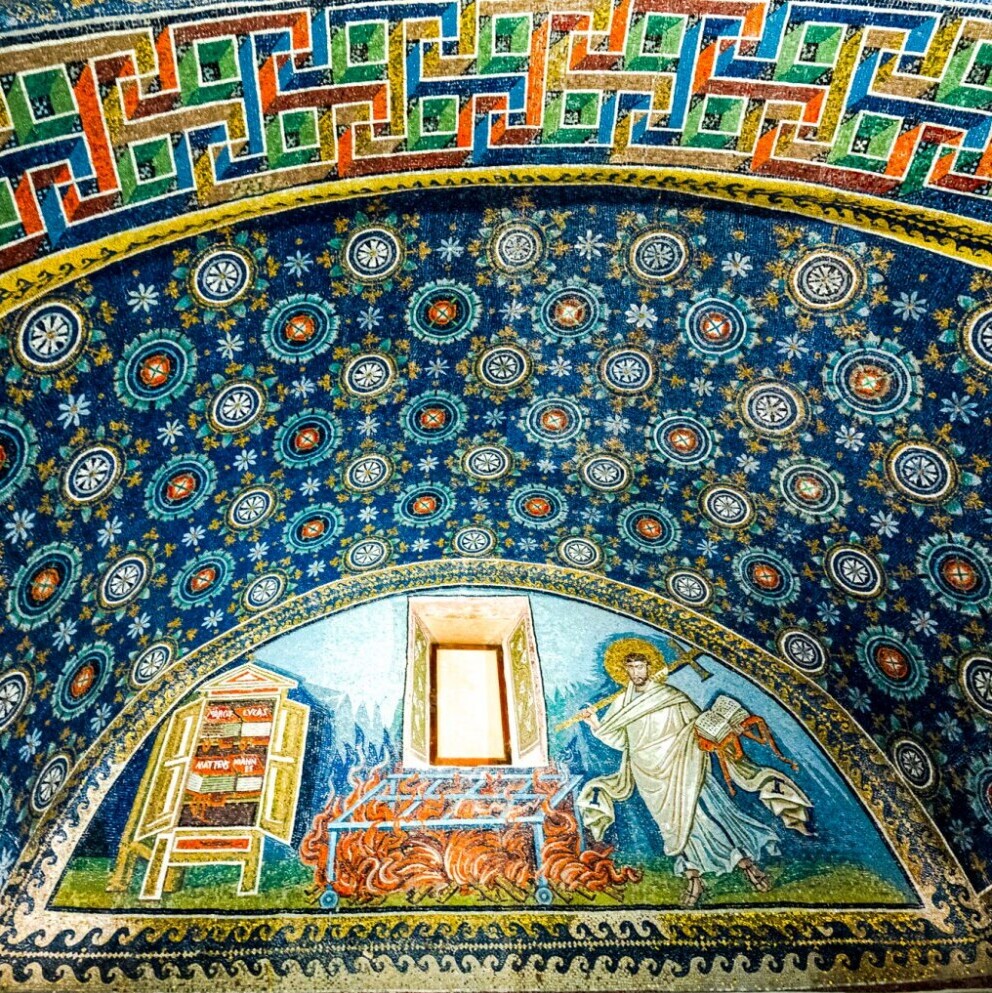 Christian Mosaic at Ravenna, Italy
Christian Mosaic at Ravenna, Italy
Ever walk into an old church or cathedral and just… wow? I’m talking about those moments when you’re completely stopped in your tracks by the sheer beauty and grandeur of the space. For some, it’s often the mosaics. The way light dances across those tiny pieces, the rich colors that seem to glow from within, and the stories they whisper – it’s absolutely mesmerizing.
If you’re anything like me, you’ve probably wondered about the story behind these incredible works of art. What are they made of? How did they get here? What do they mean? Well, let’s dive in and uncover the fascinating world of Christian mosaic art!
What Are Christian Mosaics, Anyway?
At their heart, Christian mosaics are made of small pieces of material – usually glass, stone, or ceramic – called tesserae. (Isn’t that a great word?) Imagine thousands upon thousands of these little guys, each carefully chosen and placed by an artist, like pixels in a giant, historical, and spiritually rich image. These tesserae are pressed into wet plaster, creating vibrant and durable pictures.
Think of it as the ultimate form of artistic upcycling: taking humble materials and transforming them into something truly extraordinary. But these aren’t just pretty pictures; they’re powerful storytelling tools, especially in the context of Christian mosaic artwork designs.
Visual Sermons: Mosaics in Early Christianity
In the early days of Christianity, Christian mosaic artwork tiles served a crucial purpose. Back then, a large portion of the population couldn’t read. So, how do you teach them about their faith? You show them! These mosaics weren’t mere decoration; they were visual sermons, bringing the stories of the Bible to life.
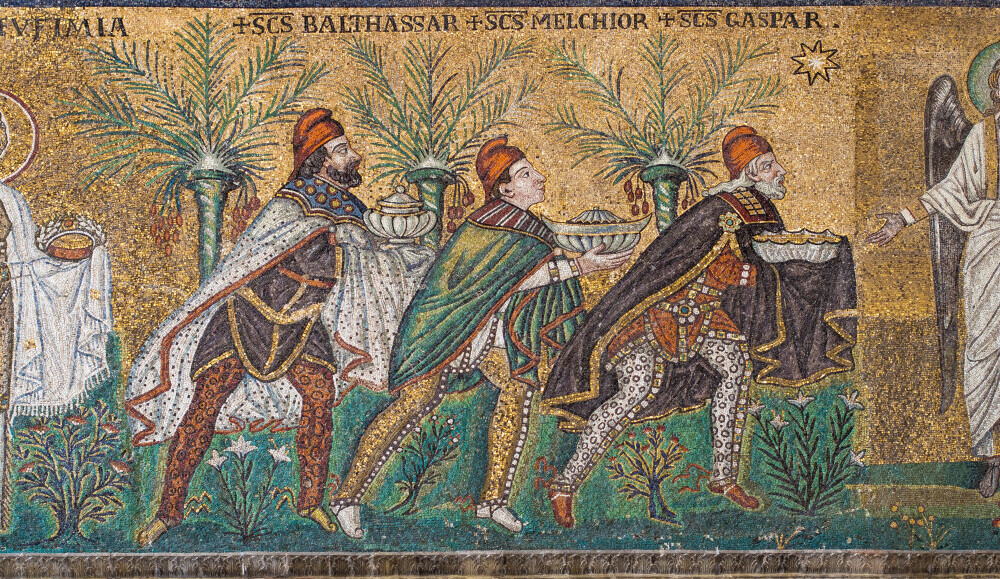 Ravenna Basilica of Sant’Apollinare Nuovo – Three Wise Men
Ravenna Basilica of Sant’Apollinare Nuovo – Three Wise Men
Think about the symbolism: A simple fish (the ichthys) representing Christ, a dove symbolizing the Holy Spirit, and grapevines hinting at the Eucharist. These were powerful, easily understood symbols that resonated deeply with early believers. The colors, too, held meaning: gold for heaven, red for Christ’s sacrifice, and blue drawing the eye upward towards hope. It’s an amazing example of how early believers developed the mosaic art styles in Christianity.
Imagine you are an early Christian in a simple house church. You look up and see scenes from the Gospels unfolding on the walls. The Nativity, Jonah and the whale, the calling of the prophets – these weren’t just stories; they were a tangible connection to their faith. No wonder these artworks were much more than decoration! They made the gospel come alive.
Speaking of early examples, have you ever heard of the Megiddo Mosaic? Discovered in Galilee, this 3rd-century floor is believed to be from one of the earliest Christian worship spaces – even before churches as we know them were common! The inscriptions and symbols offer a glimpse into the life and language of that early community, even including a phrase identifying Jesus as God. Pretty incredible, right?
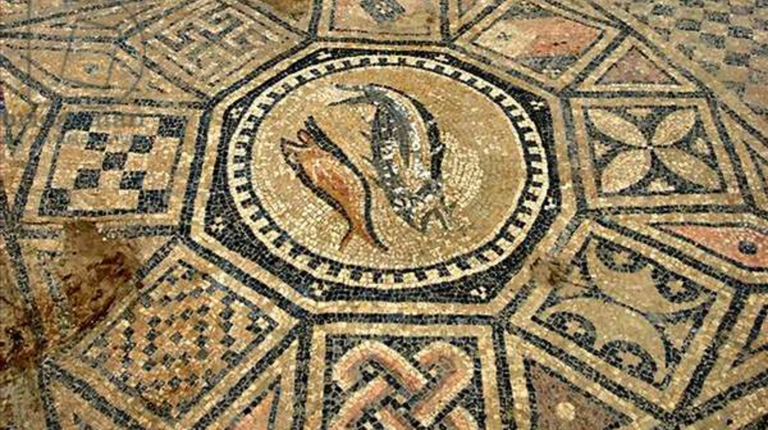 An example from the Megiddo Mosaic – a well-preserved 3rd-century AD mosaic floor discovered in 2005 at a site identified as the earliest known Christian worship hall in Israel
An example from the Megiddo Mosaic – a well-preserved 3rd-century AD mosaic floor discovered in 2005 at a site identified as the earliest known Christian worship hall in Israel
The Artists: Theologians with a Trowel
The artisans who crafted these Christian mosaic artwork designs weren’t just skilled laborers; they were theologians in their own right. They understood the power of visual communication. Each color, each material, each carefully considered placement was designed to maximize the impact of their message.
They were masters of light, too! They’d cut the glass at slight angles, so the light would flicker and dance, giving the images a sense of life and movement. Local materials, like limestone and marble, provided a solid foundation, while imported glass, gold leaf, and vibrant colors added depth and richness. Christian mosaic art history is full of these dedicated artisans.
These early techniques paved the way for the breathtaking mosaics of the Byzantine era, particularly in places like Ravenna, Italy. But we’ll get to that shortly!
From Pebbles to Paradise: The Evolution of Mosaics
The story of Christian mosaic tiles didn’t begin with Christianity. It goes way back to ancient civilizations. Think Mesopotamians embedding pebbles in temple floors, or Greeks and Romans using colored stones and tesserae to depict scenes from mythology and everyday life.
The real turning point came in the 4th century when Christians adopted the craft and transformed its purpose. Suddenly, floors became canvases for biblical stories, and walls became windows into the divine! And the materials evolved, too. Instead of rough pebbles, artists started using precisely cut glass and fine ceramics.
Glass was a game-changer! It unlocked a whole new spectrum of colors. Rivers could now be a deep, shimmering blue, and robes could radiate with fiery red. The innovation of using thin gold or silver leaf between layers of molten glass was pure genius. It created a luminous effect, like light trapped inside a tile – a light that never fades.
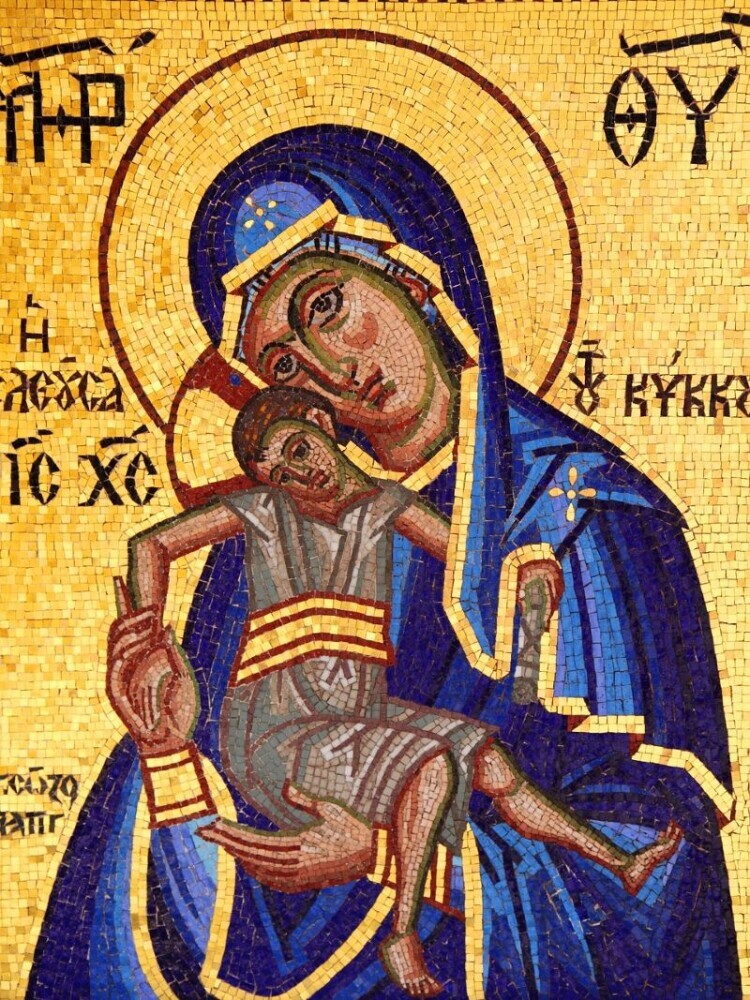
As Christianity spread, so did the techniques. Artisans became incredibly skilled at setting the tesserae, carefully applying lime plaster and angling each piece to catch the light just right. And instead of just decorating floors, they began to cover entire apses, vaults, and domes.
By the time the Byzantine style reached its peak (the 6th Century), entire walls were transformed into shimmering tapestries of glass, color, and gold. Domes seemed to glow like the rising sun, and saints appeared larger than life, watching over the congregation. This became one of the most well-known mosaic art styles in Christianity.
These advancements weren’t just about aesthetics; they were deeply connected to the act of worship. The brighter colors drew the eye towards Christ, Mary, and the apostles. The gold symbolized the light of heaven. The durable materials ensured that these scenes would endure for generations, supporting the symbolism in early Christian art–color and form working together, conveying doctrine to hearts searching for truth.
Secrets of Success: The Magic Behind the Mosaics
So, what made this mosaic artwork for churches so stunning and long-lasting? I think it boils down to a few key advancements:
* Uniform Cutting of Tesserae: By cutting smaller, more uniform cubes, artisans achieved greater precision in depicting faces, hands, and drapery. This allowed for smoother contours, more lifelike expressions, and tighter joints.
* Reflective Gold Glass: Sealing thin gold leaf inside glass transformed candlelight into a radiant glow. Imagine the dimness of an apse; suddenly, the background behind Christ seems to come alive with light! And because the glass protected the gold, its shine remained undimmed.
* Integration with Architecture: Artists started designing mosaics in harmony with the buildings they adorned. Curved domes, high vaults, and broad apses guided the layout of the images. Figures grew larger in the apse, patterns framed arches, and bands of text directed the viewer’s gaze.
These improvements led to stronger colors, more stable surfaces, and a sacred glow that permeated the space. That’s why so many Byzantine mosaics, especially those in Ravenna, continue to speak to us today with such clarity and power.
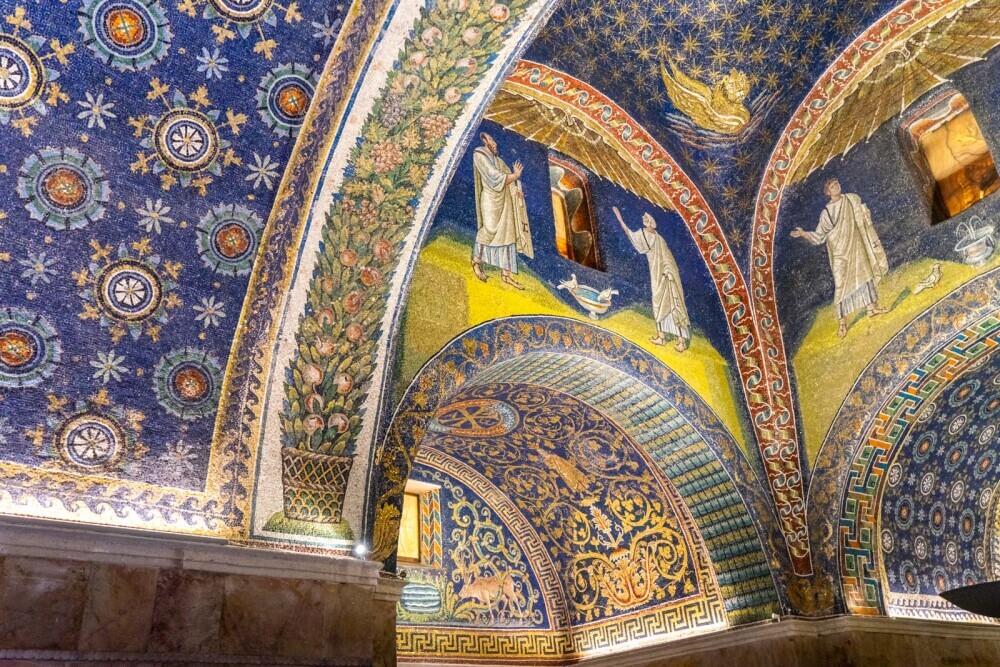 Example of Mosaics – Ravenna, Italy
Example of Mosaics – Ravenna, Italy
Decoding the Symbols: A Visual Language
Early Christian mosaics weren’t just beautiful pictures; they were a visual language, communicating the core tenets of the faith. With the rise of Christianity, pagan symbols receded. In their place came images that taught the Gospel to everyone, from farmers to sailors to children. Gold backgrounds shed a warm light across holy faces. These mosaics were a quiet sign of God’s presence, figures standing tall and sure against that gold.
Here are a few key symbols to keep an eye out for:
* Fish (Ichthys): A simple confession of faith, proclaiming Jesus as Christ, the Son of God, and the Savior.
* Lamb: Representing Christ’s sacrifice, symbolizing gentleness, purity, and the power of salvation.
* Cross: The ultimate symbol of suffering, victory, and the path to redemption.
* Vine: Representing life in Christ, signifying fruitfulness and the unity of the Church.
Even the inclusion of Christian mosaic artwork animals held symbolic meaning, drawing from both scripture and the natural world to convey deeper truths.
These symbols replaced pagan imagery, making doctrine accessible to all. They invite prayer, focus the mind, and steady the heart.
Beyond these core symbols, everyday images were imbued with deeper meaning. The Good Shepherd carrying a lamb conveyed Christ’s love and care for his flock. The alpha and omega letters reminded viewers that He is the beginning and the end. Peacocks, with their ever-renewing feathers, hinted at immortality and the hope of resurrection.
Even color played a significant role. Blue symbolized heaven and faithfulness, while red represented sacrifice and unwavering love. Together, they conveyed themes of hope, patience, and courage. These Christian mosaic tile patterns were far from arbitrary.
Iconic Examples: A Journey Through Time and Space
To truly appreciate the power of Christian mosaic tiles, you have to see them, either in person or in high-quality images. Stepping into a 6th-century basilica and experiencing the way the light dances across the gold tesserae is unforgettable.
Ravenna, Italy, is a must-see. In Sant’Apollinare Nuovo, processions of saints line the nave, their white robes shimmering in the light. The rhythm and repetition of these figures convey a sense of holiness.
But Ravenna isn’t the only place! The church floors at Petra, in Jordan, blend Christian motifs with local animals and plants, showing how faith took root in different cultures. The Huqoq synagogue mosaics in Galilee incorporate biblical scenes in bold panels, demonstrating a shared visual language across different communities.
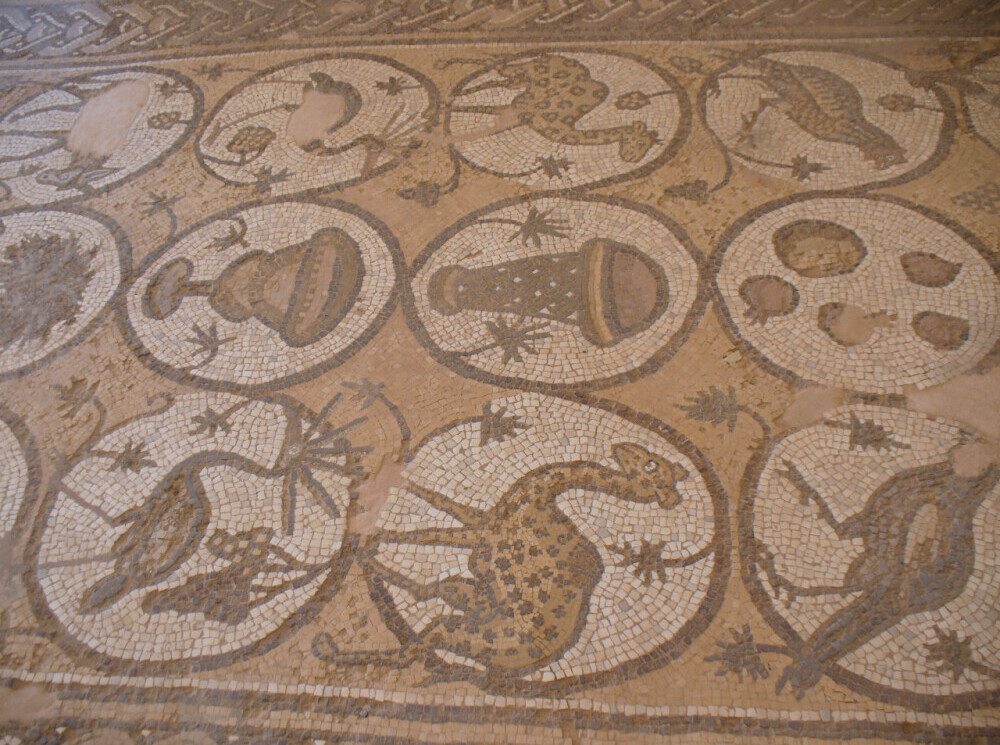 Part of Mosaic Floor – Church in Petra, Jordan
Part of Mosaic Floor – Church in Petra, Jordan
Lessons for Today: Inspiration for Us All
What can we learn from these ancient mosaics as viewers and even makers of sacred art today?
* Embrace Light and Gold: Use shimmer to evoke the presence of heaven.
* Tell Clear Stories: Make sure your images are easily understood, even from a distance.
* Incorporate Local Details: Blend faith symbols with elements that reflect your own culture and community.
San Vitale’s imperial panels of Justinian and Theodora offer a fascinating look at how mosaics can convey power and authority. The emperor and empress, in robes that gleam with gold and halos that symbolize divine rule, are flanked by clergy, soldiers, and attendants, visually representing the partnership between church and state.
The church floors in Petra show the beauty of blending Christian symbols with local flora and fauna. Such beautiful Christian mosaic artwork examples.
Conclusion: A Legacy of Light and Faith
From simple pebble floors to shimmering gold domes, Christian mosaic tiles trace a path of faith and artistic innovation. As the craft matured, tesserae grew finer, colors became more vibrant, and light became an integral part of the message. At the heart of it all is symbolism in early Christian art.
Remember the glow of Ravenna, the steadfast figures of San Vitale, and the church floors of Petra. Let these images inspire you to see the world with new eyes and to find the sacred in the everyday.
The next time you visit a church, take a moment to look up and let the light speak to you. Visit a museum and soak in the beauty of Byzantine art. Or even try creating your own small mosaic at home, using glass or ceramic tiles to craft a simple cross or vine. Share it with your family, read a psalm, and remember the first believers who prayed with their eyes. Let these ancient tiles remind you of God’s enduring light. If you want to try your hand at mosaics, there are plenty of resources and kits available online.
I hope you’ve enjoyed this little journey into the world of Christian mosaics. Until next time!
Affiliate Disclosure
Here’s a little transparency: Our website may contain affiliate links. This means if you click and make a purchase, we may receive a small commission. Don’t worry, there’s no extra cost to you. It’s a simple way you can support our mission to bring you quality affiliate marketing content.
